
Twenty years ago Atlanta hosted the Centennial Olympic Games from July 19 to August 4, 1996, with the Georgia Tech campus serving as the home of the Olympic Village — where the athletes lived — and as the venue for swimming, diving, synchronized swimming, water polo, modern pentathlon, boxing, and Paralympic volleyball.
Many of Tech’s current faculty and staff were not at Tech during the Olympics, and some of today’s undergraduates had not been born. As a result, many in the Tech community may not be aware of the herculean effort that transformed the campus for the Olympics.
This story takes a look at Tech’s role in the Olympics through the eyes of some of the key contributors. For those who were at Georgia Tech or living in Atlanta in 1996, it will be a walk down memory lane. For those who were not, we hope the story provides insight into some of the work that occurred before the Games, and how it shaped Tech’s Olympic legacy that remains today.
M I C H A E L E D W A R D S
Aquaman
Video: Michael Edwards talks about his role in planning the 1996 Atlanta Olympic Games and how Georgia Tech’s McAuley Aquatic Center is used today.
In 1996, Michael Edwards was director of Sports Facility Planning and Management at Georgia Tech. During the Olympics, he was “on loan” from Georgia Tech, at the request of the Atlanta Committee for the Olympic Games (ACOG), to be the venue manager of the Aquatic Center.
He was in charge of running two venues simultaneously—the swim stadium and water polo stadium—and managing four aquatic sports: swimming, diving, synchronized swimming, and water polo. The aquatic venue team was made up of 31 functional area managers and 3,000 volunteers.
“Any time anybody asks me about the Atlanta Olympic Games, the first thing that comes to my mind… amazing! This is the largest sporting event in the world,” Edwards said. “It put Atlanta and Georgia Tech on a stage where they had never been before. There were 271 television stations, 500 print media, and more than 300 photojournalists from all over the world.”
Edwards, now senior director of Campus Recreation at Georgia Tech, said he learned a tremendous amount from his Olympics experience.
“From a professional standpoint, I learned how to effectively manage a multi-level, complex organization,” he said. “There were many layers within ACOG as an overall organization and many layers within the venue structure itself. Getting them all on the same page and going in the same direction was a large task, but we pulled it off very well, in the case of the Aquatic Center.”
He said that hosting an Olympic venue requires strategic planning.
“If you go into an Olympic Games expecting them to come with a large pocketbook full of money and think they will solve all of your problems, you will fail. If you go into an Olympic Games with the idea that this can be a great springboard to bigger and better things for your organization, you will have greater success,” Edwards said, suggesting that the strategy must focus on how to take advantage of the opportunity.
“The 1996 Olympic Games was the lead-in to what was a great overall capital improvement period for Georgia Tech,” he said. “This was because of excellent senior leadership and vision, utilizing the momentum to grow Georgia Tech.”
Edwards said the original reason behind Georgia Tech wanting the Olympic Aquatic Center on campus was for the aquatic center to become the anchor for the further development of athletic and recreational facilities on campus.
“If you think of the development of a mall, the developer has to have the anchor stores in place before the small pieces can fall into place,” he said. “It was the same concept; the Aquatic Center was the anchor that allowed for the expansion.”
After the Olympics, Georgia Tech had an open air world-class Aquatic Center with a roof structure connected to a recreation center that was built in 1977. Many studies were conducted to decide how to best use the facility. One study suggested that enclosing the Aquatic Center would require the heating and cooling of 2.2 million square feet of unusable space above the pool. According to Edwards, this gave birth to the idea of building a floor under the existing roof structure.
“We had many who said it could not be done, but a few who said they could do it. So, we used bridge engineering and built a floor inside the existing roof and over the pool,” Edwards said.
Today, McAuley Aquatic Center is used by many metro area groups for training, and it is where Georgia Tech’s swimming and diving teams train and compete. The facility also provides instructional and recreational activities for the overall Georgia Tech community, and it was recently voted the number one collegiate aquatic center in the nation.

A N N I E A N T Ó N
Olympics Envoy
Video: Annie Antón talks about her role as an envoy during the 1996 Atlanta Olympic Games and shares her thoughts on Georgia Tech’s Olympic legacy.
Annie Antón, chair of Georgia Tech’s School of Interactive Computing, was a Tech Ph.D. student in 1996. She served as the envoy to Equatorial Guinea, and she lived in the Olympic Village during the Games. Her job was to take care of Equatorial Guinea’s Olympics team during the six weeks they were in Atlanta.
The envoys were required to undergo two years of intensive training before the Olympics. Approximately 196 volunteer envoys met every Wednesday night for two hours in the Van Leer auditorium.
“It was worth every minute,” Antón said. “As a Ph.D. student and as someone who had credentials to live in the Olympic Village, I had access to everything the athletes had access to and everything a Georgia Tech employee had access to.”
At night, she often would leave the Olympic Village and go to the College of Computing, where she would write down her thoughts about what she had experienced that day—essentially blogging before it was called blogging—and email it to her family and friends.
Antón has many other fond memories of the Olympics.
“The first thing that comes to mind when someone mentions Atlanta, Georgia Tech, and the Olympics is the feeling I had of seeing every single Olympic athlete wearing a Georgia Tech hat,” she said. “That was their welcome gift to the Village, and I knew those hats were going to suddenly be all over the world.”
Antón said that since the ’96 Olympics, people are more aware of Atlanta.
“The Games really put us on the map,” she said. “Prior to that, when meeting people I would say I’m from Atlanta, and they would ask ‘where is that?’”
She sees the lasting impact the Olympics have had on Georgia Tech and Atlanta.
“I can’t come to the Georgia Tech campus and not see the Olympic legacy every day,” Antón said. “I see it in the dorms. I see it in the [Kessler] Campanile that was built just before the Olympics. I see it in the infrastructure of the city of Atlanta. And, I see it in how much this city has transformed.”
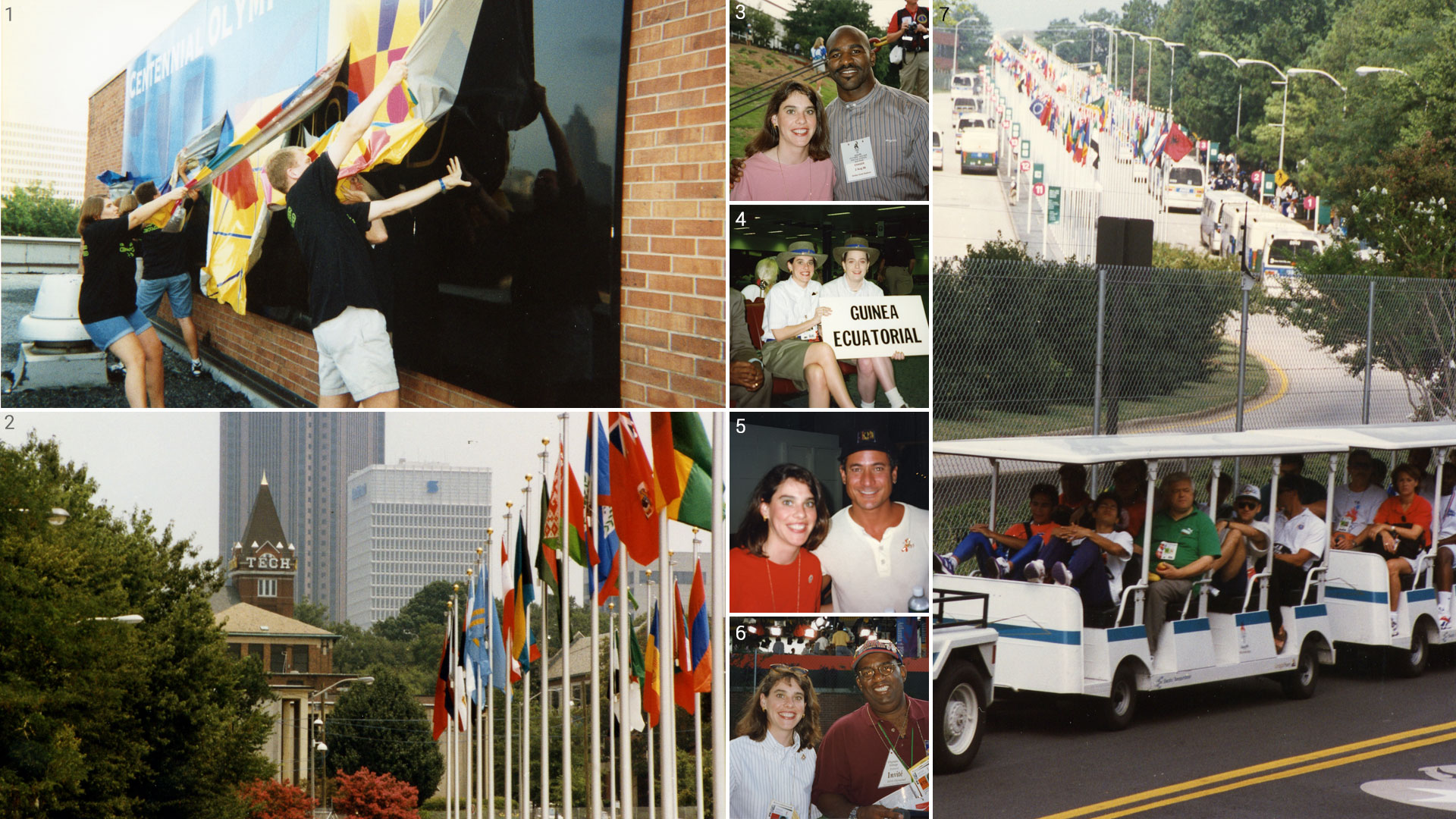
1. After the Games, Tech students removed the Olympics banner that covered the Georgia Tech sign on the Student Center. 2. In the Olympic Village, flags representing the competing nations lined Tech Parkway. 3. Annie Antón with boxer Evander Holyfield, bronze medalist in the 1984 Olympics. 4. Antón was a volunteer envoy to Equatorial Guinea. 5. Annie Antón with diver Greg Louganis, gold medalist in the 1984 and 1988 Olympics. 6. Annie Antón with Al Roker from the TODAY show. 7. Athletes and coaches rode trams in the Olympic Village. Photo credit: Annie Antón

G. W A Y N E C L O U G H
Most Valuable Player
Video: G. Wayne Clough, president emeritus of Georgia Tech, talks about leading the Institute before and during the 1996 Atlanta Olympics.
When G. Wayne Clough became president of Georgia Tech in 1994, the campus was a very large construction site, preparing for the 1996 Olympics. He had to step in and lead that effort, while keeping Tech’s mission front and center.
“When I got here, I had the sense that I had a big job on my hands and the hands of the people who were hired to do the work to prepare for the Olympics,” Clough said. “As a result of that, I thought it was very important not to allow this big thing called the Olympics to absorb our attention and keep our eye off the ball [regarding] what Georgia was all about—and that was academics and the Georgia Tech of the future.”
Clough cites many lessons learned while planning for the Olympics, particularly learning how to work as a team under compressed time schedules.
“I thought that was a learning lesson we shouldn’t forget,” he said. “As we came out of the Olympics, we had big plans. We wanted to build one major building a year, which had never been done in Georgia Tech’s history.”
The end of the Games signaled the launch of several big initiatives at Georgia Tech—a national campaign, a new strategic plan, and a new master plan.
“We wanted to shift direction for the school,” Clough said, “and we had to keep that same Olympics mentality in place. We couldn’t let it go.”
After the Games were over, Clough was proud of what Tech had accomplished.
“I was proud of the students. I was proud of the faculty. I was proud of the staff,” he said. “We all kept our eye on the ball and did a beautiful job, both for Atlanta and for the institution.”
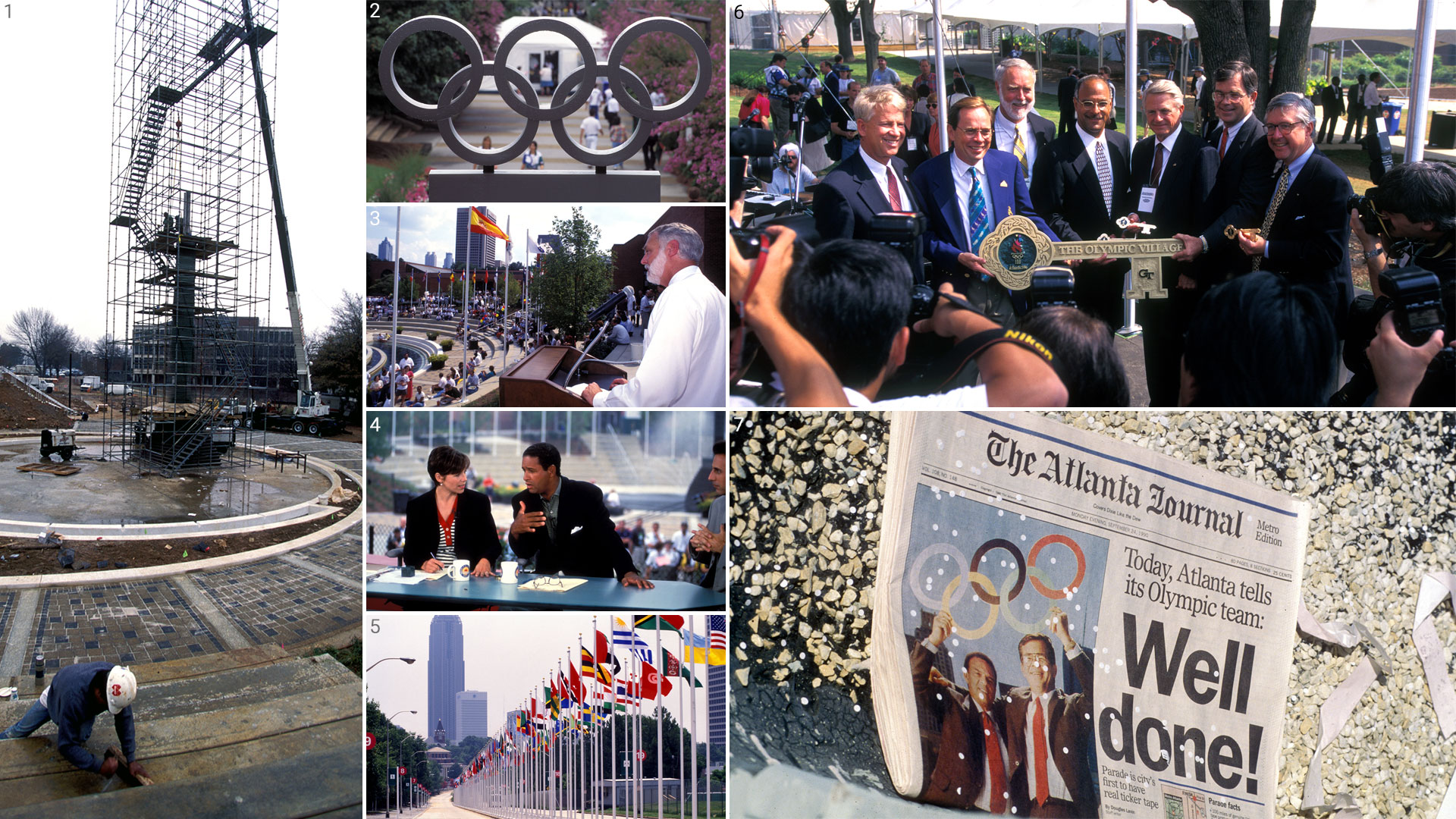
1. Kessler Campanile under construction. 2. The Olympic rings overlooking Skiles Walkway (during the Games). 3. Then-President G. Wayne Clough speaking at the Kessler Campanile. 4. Katie Couric, Bryant Gumbel, and Matt Lauer hosting the TODAY show live from the center of campus. 5. Flags lined Tech Parkway inside the Olympic Village. 6. The Olympic Village key ceremony (left to right): Georgia Lt. Gov. Pierre Howard, Mayor of the Olympic Village Russ Chandler, President G. Wayne Clough, Atlanta Mayor Bill Campbell, Georgia Gov. Zell Miller, President and Chief Executive Officer of the Atlanta Committee for the Olympic Games (ACOG) Billy Payne, and Chief Operating Officer of ACOG A.D. Frazier. 7. Front page of The Atlanta Journal: Well done! Photo credit: Georgia Tech Institute Communications

M A T T H E W R Y A N
Team Captain
Video: Matthew Ryan talks about being captain of the U.S. handball team for the 1996 Atlanta Olympics and living in the Olympic Village at Georgia Tech.
Matthew Ryan is executive director of Regional Development at Georgia Tech. In 1996 he was captain of the U.S. Olympic handball team, which finished ninth in the world, the best U.S. finish since men’s Olympic handball began in 1972.
Ryan and his teammates moved to Atlanta before the Games, and they got to know some of Georgia Tech’s researchers.
“We were the first team to reside in Atlanta,” he said. “We capitalized on the research that Georgia Tech had to offer in sports science and technology. They measured our body fat and helped with nutrition. Georgia Tech really became part of the fabric of our team prior to the Olympics.”
Ryan said that living in the Olympic Village was fantastic.
“We watched the Village develop, and we watched the campus develop. We were able to see the before-and-after.”
The first autobiography that Ryan read as a child was by Muhammad Ali, detailing his pursuit to be the best athlete in the world. So, when Ali stepped on stage to light the cauldron during the Opening Ceremonies, it was a big moment for Ryan.
“To me that was very powerful, to have my idol up there lighting the torch,” he said.
Ryan said that when he reflects on the memorable moments of the Olympics, it’s hard to fathom that it was 20 years ago.
“I’ve been able to stay in touch with the Olympic movement, and with my teammates,” he said. “I’m blessed every day to come to Georgia Tech and work with incredible colleagues who embrace a lot of the ideals that we embraced as Olympic athletes: to work hard, to overcome obstacles, and to make a difference on a global scale.”
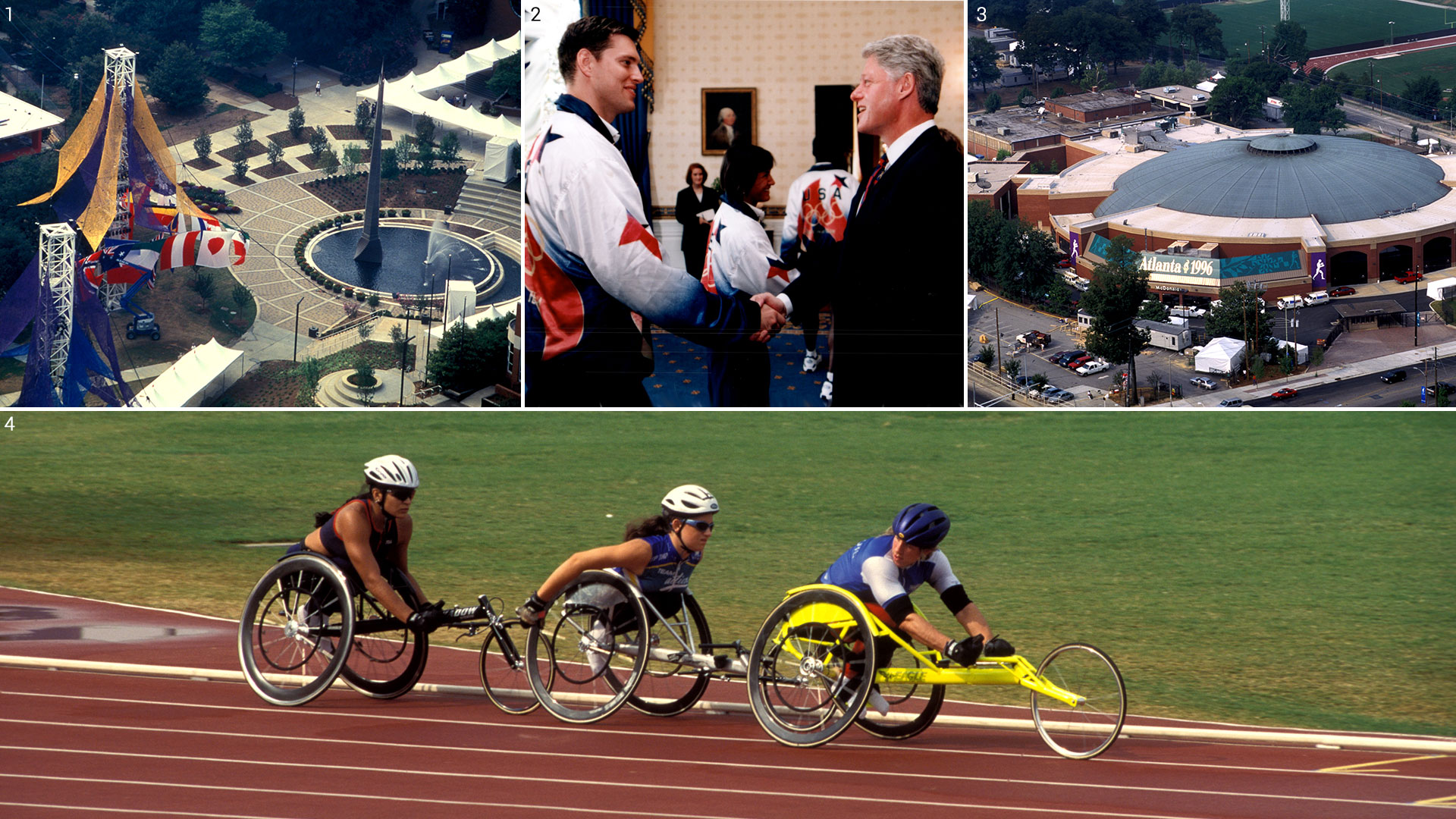
1. Aerial view of Kessler Campanile. 2. Matthew Ryan with President Bill Clinton. 3. Alexander Memorial Coliseum (now McCamish Pavilion) was the venue for boxing and Paralympic volleyball. 4. The 1996 Paralympic Games were held Aug. 16 to 25. Photo credit: Georgia Tech Institute Communications

S A M S H E L T O N
Keeper of the Olympic Flame
Video: Georgia Tech’s Sam Shelton talks about his role in creating and testing the mechanical components of the torch for the 1996 Atlanta Olympics.
In the fall of 1994, the Atlanta Committee for the Olympic Games (ACOG) asked Georgia Tech Mechanical Engineering Professor Sam Shelton to turn the artistic torch design of Malcolm Grear Associates into a working instrument.
Shelton, now a senior fellow at Tech’s Strategic Energy Institute, designed the 1996 torch with help from a Georgia Tech team including Mechanical Engineering Professor Lee Durbetaki, Industrial Design Professor Lee Payne, and then-graduate students Kevin Berry, David Craig, and Andy Delano. Tech alumnus Tim Purdy worked with the team on the design of the ceremonial cauldron.
“The primary requirement for the torch was that it could carry the flame and not go out. Wind, rain, snow, sleet… no matter what,” Shelton said.
“The Torch Relay was going to be about 15,000 miles long and involved 15,000 torch bearers. I began to slowly realize, as I got into designing the torch, that it was a much bigger project and involved many more elements than I initially understood.”
Shelton and the team tested the torch under many conditions, including carrying it to the top of Pikes Peak (14,000 feet) and testing it on horseback because that was part of the Torch Relay.
“The ultimate test was when I took it home with me and put the burning flame under the shower to see if it would stay lit,” he said.
The torch was designed to: burn for 45 minutes without refueling; withstand wind and rain; endure temperature and elevation fluctuations between Los Angeles and Atlanta; and weigh less than 3.5 pounds. The torch also had to be large enough to be visible to spectators and television cameras, while small enough to be safe for the torch bearers to carry.
ACOG manufactured 17,000 torches. Each torch had 21 parts, supplied by 21 different vendors. Shelton’s team consulted with all of the vendors to produce the torches. He said the experience of working with the Olympics was phenomenal.
“The Olympics represented world peace, mankind coming together, and overcoming adversity. It was an amazing event to think about, to witness, to live through, and be a part of helping to create it,” he said.
Ancient Greek vases provided the inspiration for the look of the torch for the Atlanta Games, which marked the 100th anniversary of the Modern Olympic Games. The Atlanta torch was approximately 32 inches tall and ranged from 2.25 inches to 3.5 inches in diameter. The crown of the torch was made of 22 outwardly spread “reeds,” representing the 22 cities that had hosted the Games at that time.

The lower part of the torch resembled a Greek column, and the handle was made of Georgia pecan wood donated by the Georgia Forestry Commission. Two gold rings held the sections together, with one ring listing the host cities and the other ring featuring the ACOG quilt of leaves motif. A threaded rod extended from the propylene fuel tank in the lower cylinder of the torch through the crown at the top, similar to an old-fashioned lamp.
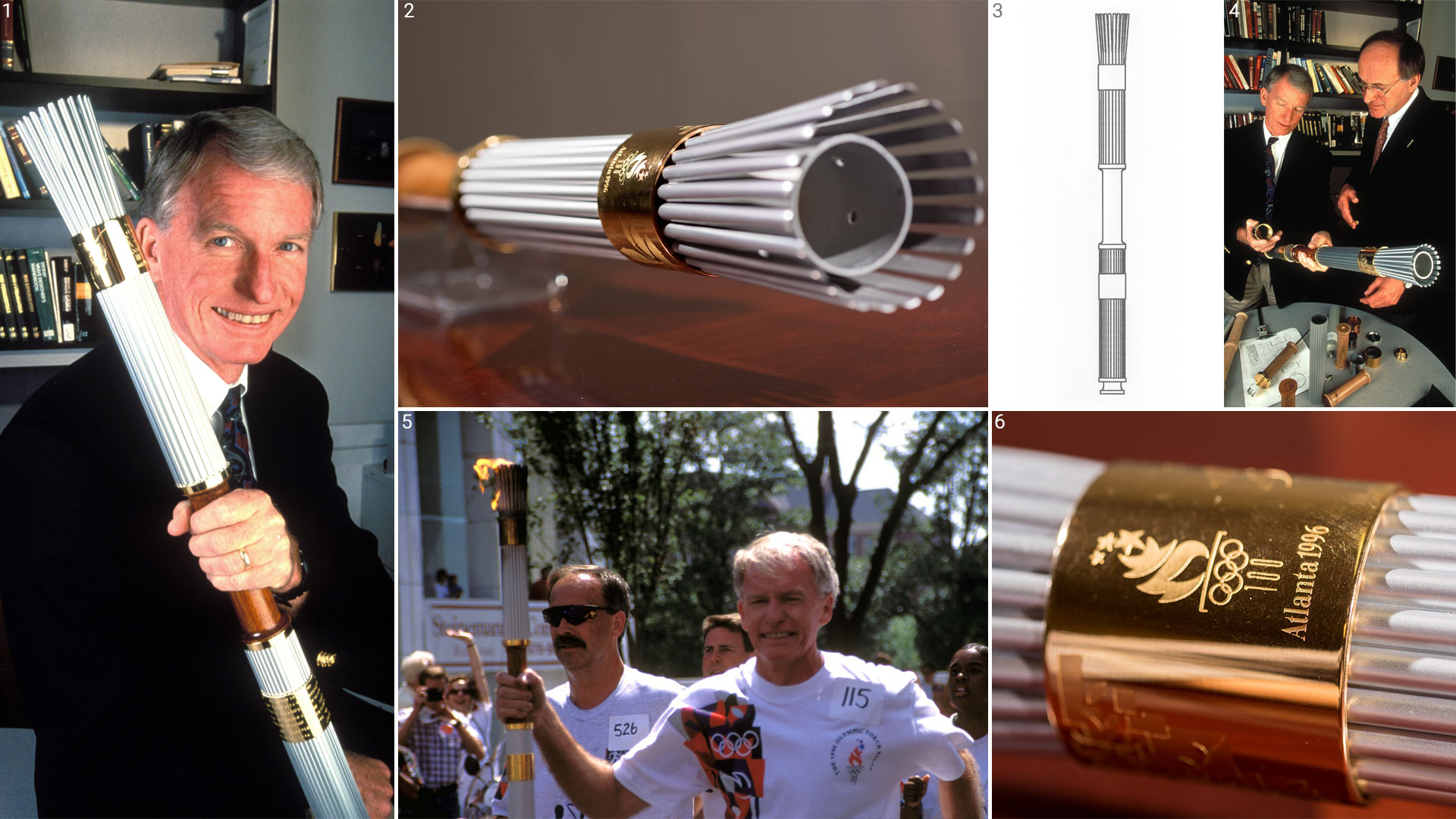
1. The Atlanta Committee for the Olympic Games (ACOG) asked Sam Shelton to design the mechanical parts of the torch. 2. The crown of the torch has 22 outwardly spread “reeds,” representing the 22 cities that had hosted the Games at the time. 3. ACOG manufactured 17,000 torches. Each torch had 21 parts supplied by 21 different vendors. 4. Shelton and Industrial Design Professor Lee Payne were members of the torch design team. 5. Shelton was one of 15,000 participants in the Torch Relay. 6. A close-up of one of the torch’s two gold rings. Photo credit: Georgia Tech Institute Communications

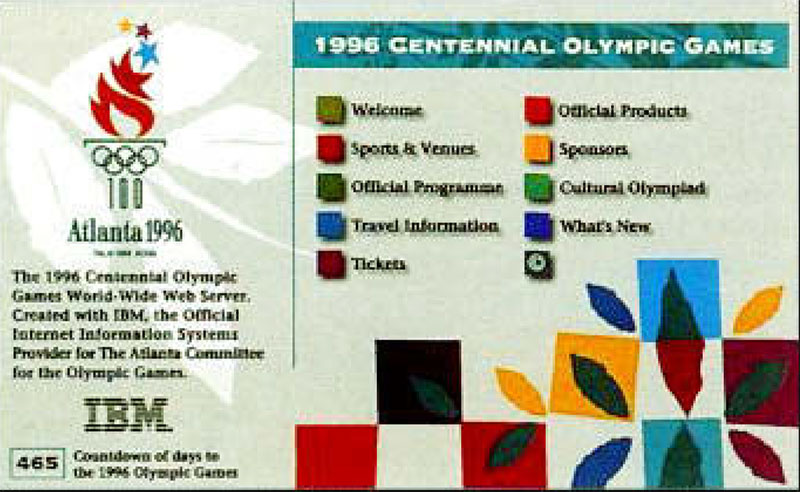
1996 OLYMPICS REPORT
"The Centennial Olympic Games World Wide Web site, the first designed for an Olympic Games, provided information about the Games to Internet users around the world." Source: Official Report of the Centennial Olympic Games.
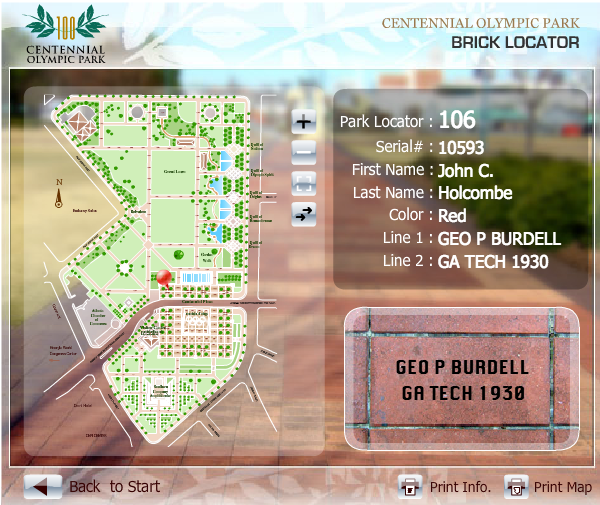
FUN FACT
Did you know that George P. Burdell has six Olympic bricks in Centennial Olympic Park? Find others in the brick locator here.
Credits
Writer/Producer: Victor Rogers
Digital Designer: Melanie Goux
Photographer: Fitrah Hamid
Videographers: Maxwell Guberman, Troy Robinson, Micah Eavenson, Adam Karcz
Georgia Tech staff and faculty personal photos used with permission.


